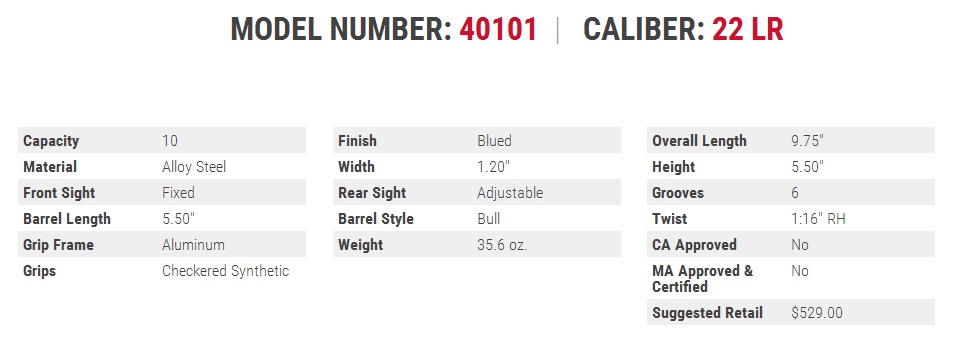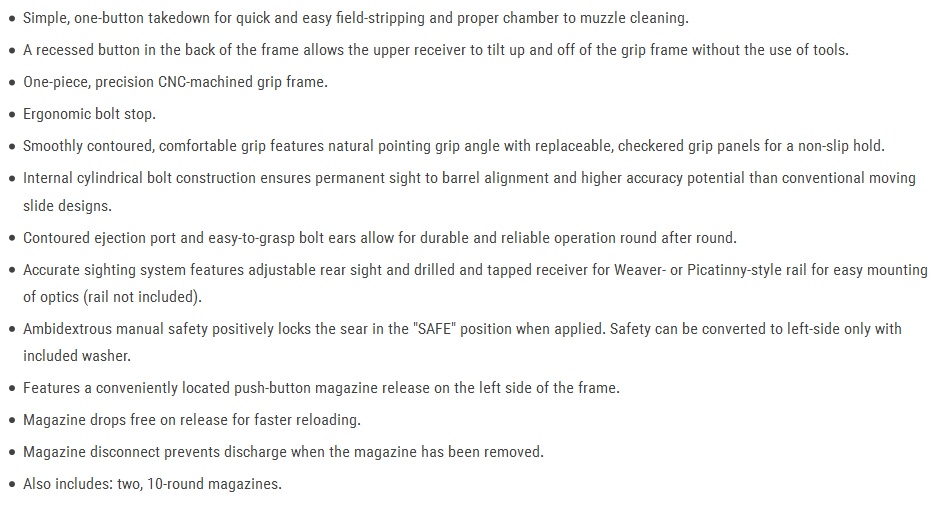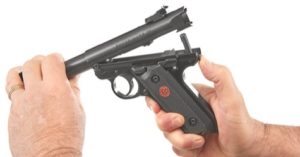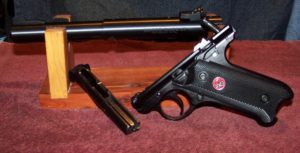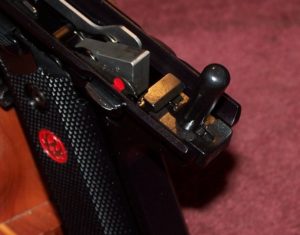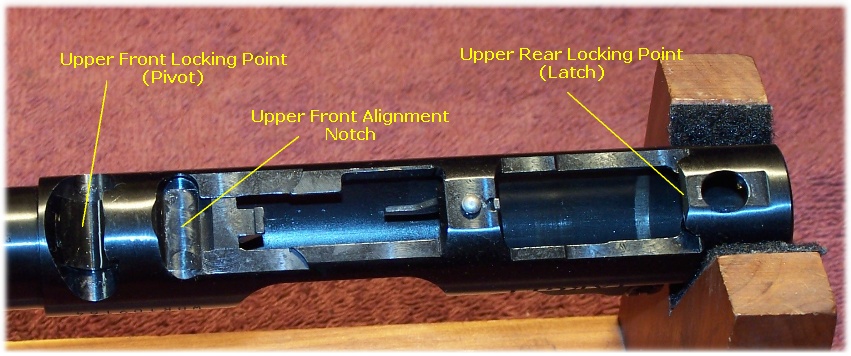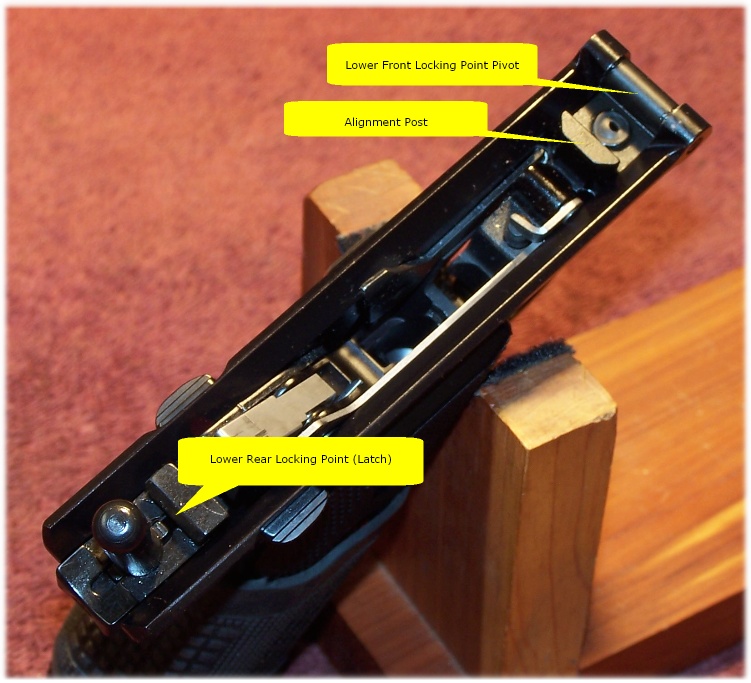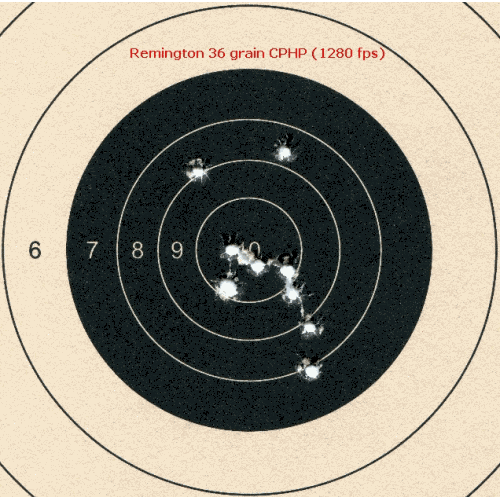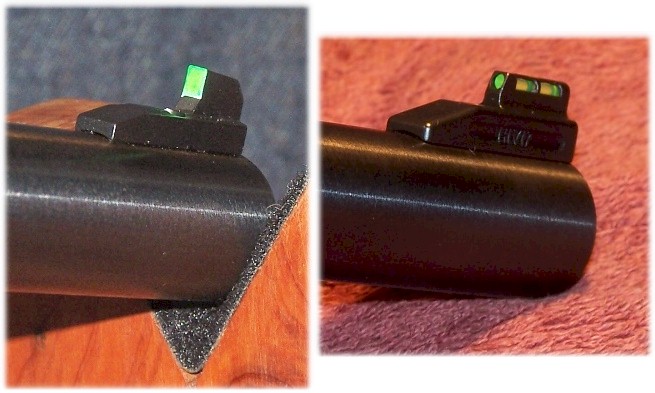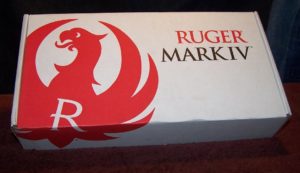 I rarely get excited about firearms that are coming out these days, although some of them are really nice. The Smith & Wesson “Victory” was an exception and it is a fine pistol of the .22 caliber persuasion. The single-point take-down system, consisting of a screw, was welcomed with me and the pistol was destined to be shot as often as possible. Well, that may have changed a bit.
I rarely get excited about firearms that are coming out these days, although some of them are really nice. The Smith & Wesson “Victory” was an exception and it is a fine pistol of the .22 caliber persuasion. The single-point take-down system, consisting of a screw, was welcomed with me and the pistol was destined to be shot as often as possible. Well, that may have changed a bit.
I have owned my fair share of Ruger “MK” pistols through the years, including a first generation MKIII 22/45 that I still own. Most of the “MK” pistols have left the fold to allow someone else the joy of disassembly and assembly and I rarely, unless I want to test my patience with disassembling and assembling the darn thing, does it see the range.
All of a sudden a surge of excitement swept through the body when I found out about the new Ruger MKIV that boasts a method of disassembly and assembly that should have been incorporated, I thought, many moons ago if Ruger was really listening to its customer base. Well, it seems that Ruger has finally seen the light – and I wanted a piece of that light.
The Ruger MKIV target model that I purchased is not “Top of the Line” although I have to say that the “Hunter” model spoke words to me. I am an everyday man like most and felt that an “everyday man’s pistol” was all that I needed. And, in all honesty, I can say that the cost of the MKIV was within the realm of what could be considered a “frugal” man’s budget.
This review is not going to go into as much detail that I am known for. Jeff Quinn of Gunblast.com (see link at end of article) does an excellent job of reviewing the “Hunter” model. Reviews of models previous to the MKIV are plentiful, and while some are exceptionally written, most can be painful to read – since the Ruger Standard pistol has been around since 1949 and I feel no need to rehash history. There are enough significant changes with the Ruger MKIV, as compared to previous model; however, that do need “hashing” and I am happy to hash those out with you.
First, let’s take a look at the basic specification and features of the MKIV.
THE KEY FEATURE:
The key feature of the Ruger MKIV is, of course, the advanced take-down mechanism that separates the MKIV form any other Ruger “Mark” pistol. No longer needed are; paper clips, mallets, or an extensive compilation of conflagrant cuss words.
When the Ruger MKIV pistol is deemed to be safe, and the magazine removed, the pistol needs to be cocked and the thumb safety lever placed in the “safe” position. Then, while holding the barrel with one hand, the thumb of the other hand presses a button inward to release the upper assembly.
Note that the Takedown Button is under spring tension; enough so that the Takedown button won’t be pushed easily and accidentally release the upper assembly.
Once the upper assembly is free from the Bolt Stop, the upper assembly can be removed from the frame. Once the upper assembly is removed from the frame, the bolt can be removed from the upper assembly. That’s it and is as simple as that.
To reassemble, place the bolt into the upper assembly.
Place the barrel/receiver assembly on top of the frame so that the notch in the receiver aligns with the pivot pin in the grip frame.
Rotate the barrel/receiver assembly down on to the bolt-stop pin in the grip frame.
Gently squeeze the barrel/receiver assembly and the grip frame assembly together so that a click is heard and check to ensure that they are firmly together and cannot be pulled apart.
Replace the empty magazine into the magazine well, point the pistol in a safe direction, place the safety in the “off” position to expose the red dot, and pull the trigger to de-cock the gun (dry-firing is safe to do with the Ruger MKIV).
It needs to be noted that once the upper is locked into place with the lower, there is absolutely no detectable play between the upper-to-lower fit.
With this new take-down and assembly system, there should be absolutely no excuse for not taking care of the pistol.
AMBIDEXTROUS SAFETY:
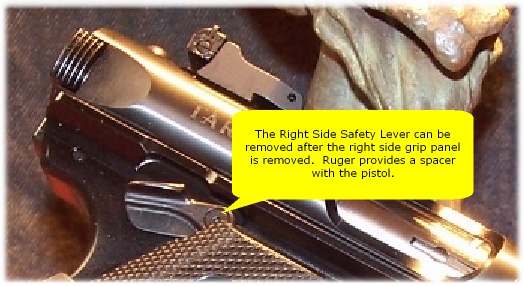 The new Ruger MKIV comes with an ambidextrous thumb safety lever – not a button as on previous versions. However, there is a feature that some stone-cold right-handed shooters may like – the right side safety lever can be removed.
The new Ruger MKIV comes with an ambidextrous thumb safety lever – not a button as on previous versions. However, there is a feature that some stone-cold right-handed shooters may like – the right side safety lever can be removed.
To remove the right-side safety lever, the right-side grip panel must be removed. Removal of the grip panels require the use of a 3/32” Allen wrench. Next, remove the right side lever using a 1/16” hex Allen wrench. Then, install a spacer (provided with the pistol) in place of the safety lever. Finally, install the right side grip panel using the original screws.
The safety lever are extended and neither seemed to interfere with the thumb of my shooting hand using a low-thumb shooting grip. I did find the safety lever difficult to move from the “fire” position into the “Safe” position when using the thumb of the shooting hand. I also had difficulty pushing the safety down with the thumb of the shooting hand. It seemed to be best, for me, to use the thumb of the support hand to operate the safety lever. With that said, the right-side safety lever did pinch my shooting hand on several occasions when moving the safety lever down into the “Fire” position. For me, the right side safety lever will be removed; one should be able to operate the safety lever without having to shift the shooting hand out of the way of the safety lever. I simply find the right side safety lever bothersome. Note that the left-side safety lever cannot be removed, at least not in the same fashion as the right-side safety lever.
BOLT-STOP THUMBPIECE:
The Bolt Stop Thumbpiece (Ruger’s term) is extended and should be within reach of most thumbs. Note that the Bolt Stop is a lever-actuated device and not a button as was previous MK II versions and is much better defined than the Bolt Stop Lever of the MK III.
GRIP FRAME:
Unlike previous Ruger MK pistol, the grip frame (the lower) is now a one-piece CNC machined lower. The lower of the “Target” model that I have is aluminum; whereas, there is a stainless steel version of the target model and the top-of-the-line “hunter” model’s lower, which is also stainless steel and all one-piece CNC machined.
GRIP PANELS:
The grip panels are of black polymer with the Ruger logo. The grip panels are fastened to the frame with 3/32” hex screws.
The texture of the grip panels is somewhat aggressive due to the diamond-checkering.
Just below the Slide Lock is what, seemingly, provides a thumb rest that keeps the thumb away from the Slide Lock lever and the Magazine Release button.
I will, no doubt, exchange the standard grip panels with something more my liking; the Ruger oversized target grips, or even the Ruger MKIV “Hunter” wood grip panels. For the time being, a Packmyr grip sleeve with finger grooves calms the harshness of the grip panels and also adds a little girth to the grip that my hand likes. I also noticed that with the larger grip radius that my normal shooting hand (right) is not being pinched by the right-side thumb safety lever. Going to a larger grip may solve two issues that I have with the pistol.
MAGAZINES:
The Ruger MKIV ships with two, 10-round magazines. Note that the Ruger MKIV also uses MKIII magazines. The magazines have a polymer base plate and the magazine can be disassembled for maintenance or parts replacement.
The Magazine Release Button, which is located just rearward of the trigger guard, is extended and sits very close the left-side grip panel. I had no problem releasing magazines without changing my shooting grip when the need arose. The magazines spring outward from the frame when they are released; no more grabbing the bottom of the magazine to strip it from the frame.
SIGHTS:
The sights are of the notch and post type without embellishment. The front sight; however, can be easily exchanged with a sight of your choosing, such as the fiber-optic sight found on the “Hunter” model, which will probably be my sight of choice.
The upper assembly is drilled and tapped receiver for Weaver or Picatinny rail for easy mounting of optics (the rail is not included).
TRIGGER:
The trigger is a curved affair with a serrated face that provides a nice surface for the trigger finger.
There is about 3/8” of slack until the trigger encounters resistance. From that point, there is an ever-so-slightly feeling of mushiness until the trigger breaks clean at approximately 4-pounds and fifteen ounces. I suspect that the trigger will smooth out after use. The trigger pull is reminiscent of the 1911 pistol, and 1911 folks should like it.
Note that because of the magazine disconnect safety; the Ruger MKIV cannot be fired with the magazine out of the pistol.
AT THE RANGE:
I had a variety of ammunition to try out in the new Ruger MKIV pistol:
- Remington 36 grain CPHP (1280 fps)
- Fiocchi 38 grain CPHP (1260 fps)
- Federal Target Grade Performance 40-grain solid (1200 fps)
- CCI 36-grain CPHP Mini-mag (1260 fps)
- CCI Blazer 40-grain LRN (1235 fps)
I decided to use the CCI 36-grain CPHP Mini-mag (1260 fps) as the “standard” and, if needed) to adjust the rear sight according to this round.
I was especially interested in how the Federal Target Grade Performance 40-grain solid (1200 fps) was going to perform, as it would not cycle the action properly in the Smith & Wesson Victory, and had the slowest velocity of all the rounds to be run.
Once sighted in, I planned on shooting a full magazine (10-rounds) of each, and then play a little with some offhand-shooting.
I also decided to bench rest the pistol throughout the accuracy portion of the shooting session and use the sights as they came from the factory – black on black, which was going to prove to be interesting since the targets that I was hoping to impact were national Rifle Association OFFICIAL 50FT SLOW FIRE PISTOL targets set at the 15 yard line – and have a black bulls-eyes. It was going to be a challenge for these old eyes in an indoor range where the lighting plays havoc on my eyes. So, and being right up front with y’all, shooting results are not indicative of the pistol but of the operator. If I could keep the majority of my shots in the 3” black circle of the target, once sighted in, it would be a very good day. In short, the Ruger MKIV is far more capable of accurate shots than I am. But, this was the first time with the pistol and I was really interested in what I could pull off.
To put things into perspective, the Ruger MKIV was not the only evaluation for the day. Earlier, I and a shooting companion were doing some 2 ¾” shotgun shell felt recoil comparisons. For the comparisons, I had Fiocchi 12-gauge 1 ounce low recoil slugs (1150 fps) vs. Remington 20-gauge 5/8-ounce Slugger (Hollow Point Rifled Slug @ 1580 fps) and 12-gauge Fiocchi low recoil 00 Buck (1150 fps) vs. Remington 20-gauge #3 Buck (1200 fps). The 12-gauge rounds were fired from a Mossberg shotgun with a 18” barrel; whereas, 20-gauge shells were fired from a Mossberg 20-gauge “Tactical” with a 20” barrel. In theory, the 20-gauge ammunition should exhibit more felt recoil than the 12-gauge ammunition, but that is a separate article completely lest I digress too far.
After a short break following the “Gauge” test, I was ready to somewhat settle into a very pleasant, very low recoil, shooting experience with the new Ruger MKIV pistol.
Every shot fired went without a hitch; no FTEs, no FTFs, Nada, nothing! The sights were spot on in that if you placed the top of the front sight on the “X”, and everything else went perfect, a hole would appear in the “X”. No sight adjustment was needed.
The Federal Target Grade Performance 40-grain solid (1200 fps) turned in the best group and cycled the action just fine, thank you. The Remington CPHP did well as did the CCI Mini-Mag (if you discard my two fliers). CCI Blazer turned in, what I feel, was the poorest performance of the lot.
Below is a slideshow of the session results. Note again that I tried to line up the sights to the center of the target as close as I could; I was trying to line of the “ghost” of the sight-lines, as the sights are really blurry to me with the indoor range lighting. And, I sure could have used a painted front sight. Those are my excuses and I am sticking to them. With that said, this was a good first time with the pistol. It can only get better from here.
L’IMPRESSIONE FINALE:
While I have always liked the “Bill Luger” line of MK pistols, the MKIV finally brings the line up to something that I really like.
The MKIV retains the look and feel of the MK line and my impression of the MK line has always favored quality, but not necessarily one of operator friendliness. With the noted unfriendly ambidextrous safety under my belt, I can say that the Ruger MKIV pistol is a quality and well thought out pistol that allows me not to use profane language as much as before regarding the take-down and, especially, the assembly procedure. I admit that during take-down I did use one profane word, and it fell between ”Well” and “Hallelujah!” The expletive was said in the most joyous of temperament since it was a blessed event.
The Ruger quality of build is apparent throughout the new Ruger MKIV pistol form the bluing, the machining, and quality of fit.
With a few personal changes to my MKIV Target pistol, I think that this pistol will be seeing many range days.
I do have to admit; however, as nice as the base-line MKIV “Target” model is, the “Hunter” model has garnered my attention now where it would have been quickly passed over before. It would seem that the “Hunter” model is very popular; my LGS has a BOLO with five different suppliers in an effort to locate one for me.
UPDATE 11/12/2016:
I had mentioned previously about replacing the grip panels that came with with Ruger MKIV “Target” model with panels for the “Hunter” model. A set was ordered and what a difference they make to the grip; much smoother without the hard checkering of the “Target” plastic grips. The wood grip panels also make the MKIV “Target” much more visually-appealing, in my opinion.
I also decided to remove the right-side thumb safety lever and replace it with the bushing that Ruger provided for doing such. It is nice not having the right-side thumb safety lever pinching the hand or embedding itself in the fleshy part of my shooting finger.

Standard Grip Panels with a much needed grip sleeve for comfort (Left) and the new Ruger Wood Grip Panels (Right)
UPDATE 11/29/2016:
I was impressed by the front sight of the Ruger MKIV Hunter model that I decided to order a set for the “Target” model.
The HI VIZ front sight is the same height as the original front sight that I had painted fluorescent green to get some contrast between the front and rear sight. The unit shipped with the green pipe installed and I decided to leave it. The green pipe just peeks above the rear sight notch when properly aligned and is much faster to pick up over the standard “Target” sight (for me).
For my taste and use for this pistol, the addition of the “Hunter” grip panels and with the HI VIS front sight, the “Target” model takes on a whole new persona and usefulness.
In my opinion, for what it is worth, the updated version should have been the “Target” model in the first place.
I plan no further upgrades
DON’ JUS’ TAKE MY WORD FOR IT:
Jeff Quinn does an outstanding job of reviewing the new Ruger MKIV (text and with video) and I have provided a link to that review below:
Ruger’s New Mark IV Semi-Automatic 22 LR Pistol: http://www.gunblast.com/Ruger-MKIV.htm
Also, watch 22Plinkster’s review of the MKIV
RUGER MARK IV REVIEW: https://www.youtube.com/watch?v=MqbiyPMA7CE
And, leave it to Hickok45 to provide his opinion:
http://www.thecollegefix.com/post/29757/: https://www.youtube.com/watch?v=HjsMSToXO60
Aside from 22Plinkster’s review of the MKIV target, he also draws some comparison to the Smith and Wesson Victory:
RUGER MARK 4 VS S&W VICTORY – WHICH IS BETTER?: https://www.youtube.com/watch?v=WETsKevL6WA
From The American Rifleman, we have:
Mark IV: The Ruger Evolution: https://www.americanrifleman.org/articles/2017/3/20/mark-iv-the-ruger-evolution/?utm_source=newsletter&utm_medium=insider&utm_campaign=0317
RESOURCES:
Ruger® Mark IV™ Rimfire Pistols: http://ruger.com/products/markIV/overview.html
![]()



